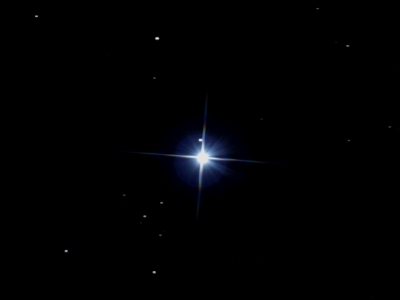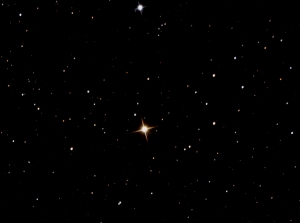

The Color of Stars
A star's life history is determined at birth, the most important factor being mass. Our own sun is an average, run of the mill G class star. When it collapsed under its own weight 4.6 billion years ago, its core got hot enough to start fusing hydrogen to helium via the proton chain reactions. The end result is a helium 4 nucleus that has less mass than 4 protons. The missing mass has been converted to energy. The fusing core heats the sun and supports it against its own gravity. It is in equilibrium. Those two things, fusing hydrogen and being in equilibrium, make our Sol a main sequence star -- a GV star. G is for the yellow color and V means it is on the main sequence. Our sun will be on the main sequence for another 5 billion plus years.



The Garnet Star M2Ia Photo -- Rick Whitten Alnitak (Zeta Orionis) O9Ib Photo -- Rick Whitten Rho Cassiopeia F8Ia Photo -- Rick Whitten
There is a relationship between mass and color for main sequence stars. Bluer stars are hotter and more massive while red stars are cooler and weigh in as dwarfs. Star colors are O, B, A, F, G, K, and M. Each color has subdivision from 0 to 9 where 9 is coolest. Our sun is a G2 V star with a surface temperature of 5780 Kelvin.
| Class | Temperature | Color | Mass | Life Time | Fraction |
|---|---|---|---|---|---|
| O | >33,000 K | blue | 16 M | 10 million yrs | 0.00003% |
| B | 10,000 K | blue white | 2.1–16 M | 400 million yrs | 0.13% |
| A | 7,500 K | white to blue white | 1.4–2.1 M | 2.5 billion yrs | 0.6% |
| F | 6,000 K | white | 1.04–1.4 M | 6 billion yrs | 3% |
| G | 5,200 K | yellowish white | 0.8–1.04 M | 12 billion yrs | 7.6% |
| K | 3,700 K | yellow orange | 0.45–0.8 M | 32 billion yrs | 12.1% |
| M | 2,000 K | orange red | 0.45 M | 70 billion yrs | 76.5% |
After stars burn all of the hydrogen in their cores, they migrate off the main sequence to become giant stars -- luminosity class I,II,II,IV and then white dwarfs in most cases. Class I stars are super giants, II bright giants, III normal giants, IV sub-giants, and V are main sequence stars. The giant stage of stars generally lasts on the order of a million years. From our main sequence table we see that only G class stars and above have had time to evolve off the main sequence since the universe is only 13.7 billion years old.
The three stars above are not main sequence stars. All three are supergiants. Stars that begin their lives with 25 solar masses or more are destined to end their lives as type II or core collapse supernovas. The Garnet star or μ Cephei has begun fusing helium to carbon and still has 19 solar masses. Alnitak weighs in at 28 solar masses, but is probably only 6 million years old. It will eventually become a red super giant before going super nova. ρ Cassiopeiae is a very rare yellow hypergiant -- one of seven known in our galaxy. It may well be the next supernova in our galaxy as it is quite unstable. In 1946 it cooled briefly to an M class star then returned to normal.